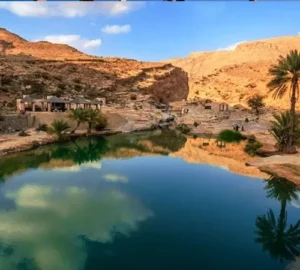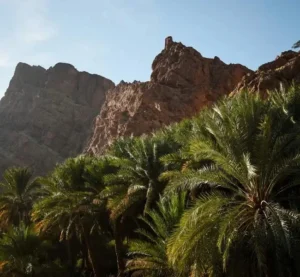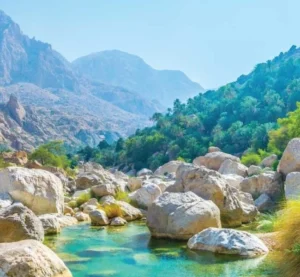Oman
UTC+4 (Gulf Standard Time)
No daylight saving time observed
Omani Rial (OMR)
Symbol: ر.ع.
One of the highest-valued currencies in the world
1 Rial = 1000 Baisa
November 18 (Birthday of Sultan Qaboos, who ruled 1970-2020)
Current ruler: Sultan Haitham bin Tariq (since 2020)
One of the oldest continuously independent states in the Arab world
e-Visa available for most nationalities
Visa on arrival for many countries
GCC nationals: visa-free entry
Culture
Oman's culture reflects its strategic position at the crossroads of trade routes between East Africa, the Indian subcontinent, and the Arabian Peninsula. With a history spanning thousands of years, Omani culture blends traditional Arab, Bedouin, and maritime influences while maintaining a distinct identity that sets it apart from neighboring Gulf states.
Key elements of Omani culture include:
- Religious influence: Islam is the state religion and shapes many aspects of daily life. The majority of Omanis follow the Ibadi branch of Islam, which is known for its tolerance and moderation. This distinct religious identity has contributed to Oman's reputation for religious tolerance, with Hindu temples and Christian churches operating freely in the country.
- Traditional hospitality: Known as "karam" in Arabic, hospitality is central to Omani culture. Visitors are typically welcomed with Omani coffee (kahwa) served in small handleless cups, accompanied by dates or halwa (a sweet gelatinous dessert with cardamom, saffron, and nuts). The coffee ceremony itself is a cultural ritual that reflects Oman's Bedouin heritage.
- Maritime heritage: With over 1,700 km of coastline, Oman has a rich seafaring tradition. Historically, Omani sailors established trade networks reaching from East Africa to India and China. This maritime legacy is celebrated in traditional boat-building practices, fishing communities, and the continued importance of ports like Muscat and Salalah.
- Frankincense heritage: For millennia, Oman was the world's primary source of frankincense, a valuable aromatic resin used in religious ceremonies, perfumes, and medicines across ancient civilizations. The frankincense trees of Dhofar and the ancient trade routes are now UNESCO World Heritage sites, and the fragrant resin remains an important part of Omani culture, used in homes to welcome guests and during special occasions.
Traditional Omani attire is both distinctive and practical for the climate. Men typically wear the dishdasha, a long white robe, with a small embroidered cap (kumma) or a turban-like headdress (massar). Women wear colorful dresses over trousers (sirwal) and a head covering (lihaf), often with elaborate silver jewelry, particularly for special occasions. Silver jewelry carries significant cultural importance, with traditional designs varying by region.
Omani cuisine reflects the country's historical connections:
- Majboos: A fragrant rice dish cooked with spiced meat (typically chicken, lamb, or fish)
- Shuwa: Marinated meat slow-cooked in an underground sand oven, traditionally prepared for Eid celebrations
- Mashuai: Whole spit-roasted kingfish served with lemon rice
- Harees: A porridge-like dish of wheat mixed with meat
- Halwa: A gelatinous sweet made with clarified butter, honey, eggs, and spices such as saffron and cardamom
Music and dance play important roles in Omani culture, with traditional forms varying by region. Performances often involve drumming, dancing with swords or canes, and call-and-response singing. Notable styles include the coastal azi and the mountain-region razha. Handicrafts remain vibrant, with regional specialties including silver jewelry, pottery, weaving, and khanjars (traditional curved daggers worn as part of ceremonial dress).
Tourism & Best Sites to Visit
Oman offers a distinctive travel experience, combining pristine natural landscapes with well-preserved cultural heritage. Unlike some of its neighbors, Oman has developed tourism thoughtfully, focusing on quality over quantity and preserving its authentic character and traditions.
Here are some of Oman's most remarkable destinations:





Mutrah Souq: One of the oldest marketplaces in the Arab world, this traditional covered souq in Muscat offers a labyrinth of narrow alleyways filled with shops selling everything from spices and frankincense to silver jewelry, traditional textiles, and antiques. The souq's atmospheric lighting, fragrances, and architecture create an authentic Arabian experience.
Wahiba Sands: A vast desert of golden sand dunes stretching approximately 180 km north to south and 80 km east to west. Visitors can experience traditional Bedouin culture at desert camps, enjoy activities like dune bashing, camel riding, and sandboarding, and witness spectacular sunsets over the dunes. The desert is home to Bedouin tribes who have inhabited this harsh environment for generations.
Jebel Shams: Oman's highest mountain (3,009 meters) features the spectacular Wadi Ghul, often called "Oman's Grand Canyon." The dramatic views from the rim, along with hiking trails like the famous "Balcony Walk" that skirts the canyon's edge, make this a must-visit for outdoor enthusiasts. The area also contains traditional mountain villages where ancient lifestyles persist.
Nizwa Fort: A 17th-century fortress that was once a pivotal stronghold of Oman's interior region. Its massive central tower, intricate defense systems, and museum of historical artifacts offer insight into Oman's military and political history. The adjacent Nizwa Souq is famous for its Friday goat market, silver handicrafts, and pottery.
Wadi Shab: A stunning natural oasis featuring emerald pools nestled between dramatic canyon walls. A hike through date palm plantations and along the wadi's rocky path leads to a series of natural swimming pools and a hidden cave with a waterfall, accessible only by swimming. This wadi exemplifies Oman's diverse natural beauty and offers a refreshing retreat in the hot climate.
Other remarkable destinations include the historic coastal city of Sur with its traditional dhow shipyards; the lush southern region of Salalah, which transforms into a verdant landscape during the annual khareef (monsoon) season; the ancient archaeological sites of Al Baleed and Khor Rori, part of the "Land of Frankincense" UNESCO World Heritage site; the breathtaking fjords of Musandam Peninsula, often called the "Norway of Arabia"; and Sultan Qaboos Grand Mosque in Muscat, a masterpiece of modern Islamic architecture.
Transportation
Oman has invested significantly in its transportation infrastructure, developing modern highways, airports, and ports. However, public transportation options remain somewhat limited, making rental cars the preferred choice for most visitors exploring beyond major cities.
- Rental cars: The most popular and practical way to explore Oman. The country has an excellent road network with well-maintained highways connecting major cities and tourist destinations. Road signs are in both Arabic and English, making navigation relatively straightforward. An international driving license is required for visitors. For exploring remote areas like mountain regions and wadis, a 4WD vehicle is highly recommended or even essential.
- Taxis: Readily available in Muscat and other major cities. Taxis in Muscat are orange and white (with newer ones being blue and white) and generally operate without meters, so it's important to agree on a fare before starting your journey. In recent years, app-based services like OTaxi have begun operating in Muscat, offering more transparent pricing.
- Buses: The Oman National Transport Company (ONTC) operates intercity bus services connecting major towns and cities. These buses are comfortable, air-conditioned, and reasonably priced. The main hub is in Ruwi, Muscat, from where buses depart to destinations including Salalah, Nizwa, Sur, and Sohar. Within Muscat, the Mwasalat bus service offers routes covering major parts of the city.
- Domestic flights: For longer distances, particularly between Muscat and Salalah or Muscat and Khasab (Musandam), domestic flights operated by Oman Air and SalamAir offer time-saving alternatives to road travel. These flights are especially popular during the khareef (monsoon) season when visitors flock to Salalah for its unique green landscape.
- Boat services: Fast ferry services operate between Muscat and coastal towns like Khasab and Dibba in Musandam Peninsula, as well as to Masirah Island. Dhow cruises are popular tourist activities in Musandam and along Muscat's coastline, though these are more recreational than practical transportation.
Transportation tips: Consider these factors when planning travel in Oman:
- Distances between attractions can be substantial, with driving times often longer than expected due to mountainous terrain
- Fuel is inexpensive compared to many countries, making road trips economical
- Navigation apps like Google Maps work well in most areas, though remote regions may have limited coverage
- During summer months (May-September), daytime temperatures can be extremely high, affecting travel comfort and vehicle reliability
- Roadside assistance services exist but coverage may be limited in remote areas; carrying extra water is always advisable
Border crossings: Oman shares borders with the UAE, Saudi Arabia, and Yemen. The most frequently used border crossings are with the UAE, particularly at Al Wajajah (connecting to Al Ain) and Hatta. These crossings are generally straightforward for tourists with proper documentation, though regulations can change. The border with Yemen is currently closed to tourists due to security concerns.
Airports
Oman has developed modern airport facilities to support its growing tourism industry and international connections. The country's airports provide efficient gateways for visitors exploring different regions.
- Muscat International Airport (MCT): Oman's primary gateway and one of the most modern airports in the Middle East since its complete redevelopment opened in 2018. The spacious terminal features state-of-the-art facilities including duty-free shopping, dining options, lounges, a hotel, and prayer rooms. The airport serves as the hub for Oman Air and SalamAir, with connections to destinations across Europe, Asia, Africa, and the Middle East. Its architecture incorporates traditional Omani elements while providing modern convenience.
- Salalah Airport (SLL): The second-largest airport in Oman, serving the southern Dhofar region. This modern facility handles both domestic and international flights, with increased traffic during the khareef season (June-September) when tourists visit to experience the unique monsoon climate. The airport was completely rebuilt and expanded in 2015, featuring similar amenities to Muscat International Airport though on a smaller scale.
- Duqm Airport (DQM): A newer regional airport serving the rapidly developing industrial and economic zone of Duqm. While currently handling primarily domestic flights, the airport is designed to accommodate future growth as the Duqm Special Economic Zone expands.
- Sohar Airport (OHS): Located in northern Oman, this airport primarily serves domestic routes and some international flights to neighboring countries, supporting the industrial port city of Sohar.
- Khasab Airport (KHS): A small airport serving the Musandam Peninsula, Oman's northernmost region which is geographically separated from the rest of the country by the UAE. This facility handles limited domestic flights connecting to Muscat.
Airport Transportation: Options for reaching your destination from Omani airports include:
- Taxis: Available at all airports with fixed rates to major destinations. At Muscat International Airport, orange and white taxis (and newer blue and white ones) operate from designated stands outside the arrivals area.
- Airport shuttles: Some hotels offer airport pickup services, particularly in Muscat and Salalah. These should be arranged in advance.
- Car rental: All major airports have rental car counters in the arrivals area, with several international and local companies represented. Advance booking is recommended, especially during peak tourist seasons.
- Public buses: Mwasalat operates bus services connecting Muscat International Airport to key locations in the city. This is an economical option for travelers on a budget.
Important notes: Oman's airports enforce security measures similar to other international facilities. Arrive at least 2-3 hours before international flights. Photography is restricted in certain areas of the airports due to security regulations. When departing, be aware that Oman strictly prohibits carrying certain items including pork products, pornography, and materials deemed offensive to Islamic values.
Visa & Travel Information
Oman has streamlined its visa procedures in recent years to encourage tourism, introducing e-visas and expanding visa-on-arrival eligibility for many nationalities. The country strikes a balance between welcoming international visitors and maintaining its cultural integrity.
Visa Options by Nationality
The following table outlines the main visa options for visitors to Oman:
| Nationality | Visa Options | Maximum Stay |
|---|---|---|
| GCC Countries (Bahrain, Kuwait, Qatar, Saudi Arabia, UAE) | Visa-Free | ID card sufficient for entry, unlimited stay |
| USA, UK, Canada, EU, Australia, New Zealand, Japan | e-Visa | 10, 30, or 365 days depending on visa type |
| Many Asian and Eastern European countries | e-Visa | Usually 10 or 30 days |
| Countries not eligible for e-visa | Regular Visa Required | Varies by visa type |
e-Visa Process: Oman's e-visa system allows for convenient online application through the Royal Oman Police website. The process typically requires:
- A passport valid for at least 6 months beyond your planned stay
- A digital passport photo
- Proof of accommodation and return/onward travel (may be required)
- Payment of visa fees (varies by visa type and nationality)
Processing times for e-visas are usually quick, often within 24 hours, though applying a few days before travel is recommended. Tourist visas are typically available for 10 days (26 OMR) or 30 days (52 OMR), with options for single or multiple entry depending on nationality.
Important Travel Considerations
- Climate: Oman has a hot desert climate in most regions. Summer temperatures (May-September) frequently exceed 40°C (104°F), making outdoor activities challenging. The exception is the southern Dhofar region around Salalah, which experiences a monsoon season (khareef) from June to September, bringing moderate temperatures and lush vegetation.
- Dress code: While Oman is relatively moderate compared to some neighboring countries, modest dress is expected, particularly outside tourist resorts. For men, shorts should cover the knees, and shirts should cover the shoulders. Women should cover shoulders and knees, with loose-fitting clothing that doesn't emphasize the figure. At beaches and hotel swimming pools, standard swimwear is acceptable.
- Religious considerations: Oman is an Islamic country, and visitors should respect local customs, particularly during Ramadan when eating, drinking, and smoking in public during daylight hours should be avoided. The call to prayer can be heard five times daily, and businesses may briefly close during prayer times.
- Photography: While photography is generally welcomed, it's important to ask permission before photographing people, particularly women. Photography of military installations, government buildings, and some infrastructure like ports is prohibited.
Best time to visit: The ideal time to visit most of Oman is during the winter months from October to March when temperatures are pleasant for sightseeing and outdoor activities. The exception is the Dhofar region around Salalah, which is most popular during the khareef season (June-September).
- October-March: Ideal temperatures (20-30°C) for most of the country, best for desert camping, mountain trekking, and city exploration
- April-May and September: Transitional months with increasingly hot temperatures but fewer tourists and potentially lower prices
- June-August: Extremely hot in most regions (40°C+), but perfect for visiting Salalah during the khareef when temperatures are cooler and the landscape transforms into lush greenery
Safety: Oman is considered one of the safest countries in the world for travelers, with a very low crime rate. The Omani people are known for their hospitality and friendliness toward visitors. Basic precautions with valuables are still advised, particularly in crowded areas. The greatest safety risks come from natural hazards such as flash floods in wadis during rainy periods and extreme heat during summer months.
Health: Healthcare facilities are excellent in major cities, particularly Muscat. No specific vaccinations are required for entry, though standard travel vaccinations are recommended. Tap water is generally safe in urban areas, but bottled water is widely available and recommended for visitors. Travel insurance with good medical coverage is advisable, as healthcare for visitors can be expensive.